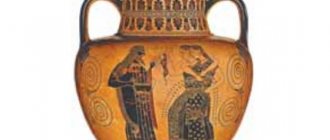Who is Princess Olga?
According to ancient chronicles, the girl was of peasant origin. Thanks to her positive qualities, as well as extraordinary wisdom, as a young teenager she was noticed by Grand Duke Igor and chosen by him as his wife. It so happened that for quite a long period the princely couple had no children. This fact contributed to the fact that Olga began to pray to the Christian God, and after a short time the couple had an heir. Thus, Olga was the first among the pagan people to accept Christianity and began to help spread it in Rus'. In a sense, the very fact of Olga’s decision to accept the Christian faith testified to her rationality and subtle intellect. Despite this, Olga's husband and son remained faithful to their pagan gods, who helped them in battles. Nevertheless, Olga’s actions had an important influence on her grandson, Prince Vladimir, who baptized Rus'. He also chose the Christian religion as the state religion.
The pacification of the rebellious Drevlyans
Where is she from, Princess Olga, what kind of family? Was she of noble birth or born into a simple family? The chronicles do not give an exact answer to this question. According to some sources, Prince Igor accidentally met Olga while hunting in his domain and fell in love with the humble girl so much that he made her a princess.
There is no information about her youth either. Her story begins after the death of her husband, when she, with the support of the governor, took the princely throne before her son Svyatoslav came of age.
The first thing Olga did was to restore order in the lands under her control with a firm hand. Traditions have preserved information about this as revenge against the Drevlyans. Their head Mal, allegedly wanting to marry Olga in order to annex Kyiv to his possessions, sent messengers to Olga. The princess ordered them to be buried in the ground, and she asked to tell Mal that she was not against getting married, but she needed more noble Drevlyans to come to Kyiv, otherwise the residents of Kyiv would not give consent to the marriage. Mal fulfilled the condition. The second batch of messengers awaited death in a burning hut, set on fire on Olga's orders.
Next, the stern princess went to the Drevlyans and besieged their city of Korosten. Having waited until the besieged began to beg for mercy, she said that she would leave the city if its inhabitants sent several pigeons from each yard to her. The Drevlyans, who believed her, hastened to fulfill the demand, but did it on their own: Olga tied smoldering coals to the paws of the birds, and, returning home, they set the city on fire.
This was the end of Olga's revenge. Through the prism of centuries, it is no longer clear whether all her actions related to the Drevlyans and whether it was revenge for the death of her husband, or whether she similarly pacified everyone who tried to rebel, but only after some time peace and quiet were established in the state.
Accession to the throne
Princess Olga became a widow early: during the collection of tribute, Igor was brutally killed by the angry Drevlyans. Since the heir was still small, the princess herself ascended the throne.
The first thing she did was deal with the Drevlyans who executed her husband, sharply suppressing their uprising. After this, a period began during which the reforms of Princess Olga were implemented. During this time, structural changes occurred in the system of government. Olga’s main task was to prevent future incidents similar to the one that led to the death of her husband.
Authorities in the ancient state
At this time, there was only one authority - the prince. The prince’s squad can also be called an authority. It was the princely squad that was the official body that collected tribute in Ancient Rus'. Naturally, the collection of taxes took place under the supervision of the princess. However, this authority of the squad is regulated in Russian Pravda. The squad received income, which was provided by the population. In addition, the population was obliged to provide any funds if the vigilante was on duty. Then another type of relationship appeared in the state, which was called “non-feudal-vassal”.
The bulk of the state's population were community members, that is, free peasants who were part of various communities. Since there was no land ownership, the treasury received revenues that brought taxes. The definition of the word “lesson” in Ancient Rus' of that time was still unknown. However, taxes were generally binding. Very harsh rules were applied for non-payment of taxes, including the death penalty.
Innovations and transformations
What reforms did Princess Olga carry out? First of all, she took up the issue of collecting tribute, establishing an orderly system of taxation. Princess Olga carried out a reform, the purpose of which was to weaken tribal power by strengthening its influence. This event is described in the “Tale of Bygone Years” by Nestor: “And Olga went with her son and her retinue across the Drevlyansky land, establishing tributes and taxes.” Princess Olga's reforms began in 946.
Prince Igor: the beginning of everything
To understand what a lesson was in Ancient Rus', you need to know where it all began. We will begin to look at history from the reign of Prince Igor Rurikovich, who did not become a strong figure in the management of the Russian state, but went down in history as a prince who could not cope with his people because of his stupidity and greed.
Prince Igor began to rule after the death of Prophetic Oleg. Throughout his reign, the prince did not show himself as a worthy ruler. At the same time, he did not show himself as a bad prince. The only thing that Prince Igor became famous for was his unsuccessful attempts to attack Byzantium. It is also worth noting that thanks to Igor, the trade agreement with the Greeks, which was concluded by Prince Oleg the Prophet, was continued. This condition was convenient for Rus' at that time.
The meaning of churchyards
Princess Olga's reforms did not end there. An important innovation was the establishment of graveyards. They were small centers of princely power. From now on, each administrative district acquired its own graveyard and camp where tribute was collected. Churchyards were also used for trade. Thus, the administrative reforms of Princess Olga contributed to the creation of territorial divisions that were under the authority of the prince’s governor and capable of repelling anyone dissatisfied with the policies and decrees of the princess. Later, by the 12th century, churchyards turned into district control centers.
Before Olga's reign, tribute collection was carried out in the form of a polyudya - an annual winter tour of the estates of government officials, during which tax could be collected twice from one household. Of course, this fact caused dissatisfaction and indignation among payers. However, with the introduction of graveyards, people who brought tribute received a special princely seal, which protected them from collecting the tax again. Olga carefully put this reform into action, gradually honing its mechanism. During the implementation of the new system, most local princes lost their power, and the independence of autonomous tribes was sharply curtailed. The work carried out by Olga did not receive publicity or enthusiastic reviews, but it was of great importance in the development of statehood.
The princess's rise to power
After the death of Prince Igor, his wife, Princess Olga, comes to power in Rus'. Russia has always been ruled by strong warriors, so Olga had a difficult task: she needed to prove her strength and show the whole state that she, too, was a strong person who was capable of ruling the country. In ancient chronicles you can find four actions of Princess Olga, which are of great importance for the development of Russian history.
The reign of the princess begins with revenge for the death of Prince Igor. This was the first act mentioned in the chronicles. As revenge, Princess Olga, together with her son Svyatoslav, burned the capital of the Drevlyans to the ground. During the fire, many Drevlyan ambassadors died. This act proved the strength of a woman, despite the fact that throughout the Russian state, a woman was considered a weak-willed creature who had to run a household and raise children.
But let's not go off topic. What is a lesson in Ancient Rus'? After completing her revenge, the princess decided to take up state affairs in order to eliminate economic and political problems in the country.
Approval of tiuns
The next stage was the appointment of tiuns as tribute collectors at churchyards. Before entering the Old Russian state, the Eastern Slavs called the tiuns “cattlemen.” First of all, this reform testified to the development of commodity-money relations. Instead of livestock, the Russians adopted a special form of equivalent, reminiscent of metal money.
If we briefly list the reforms of Princess Olga, we can highlight certain aspects. This is the approval of lessons, the creation of graveyards and the appointment of tribute collectors. During her reign, Princess Olga carried out the first financial reform in Rus'. She established a fixed amount of tribute and the procedure for its collection. The meaning of Princess Olga's activities was to normalize duties, centralize Kyiv power, and weaken local (tribal) power.
In other words, the reforms of Princess Olga contributed to the fact that the tribute that was collected from autonomous tribes was replaced by the same flat tax, which was paid by the entire population. At the same time, the possibility of repeated collection from one payer was avoided.
Thus, the reforms of Princess Olga finally established the central power of Kyiv, streamlined the taxation system, and created an administrative division of the state. Later, Olga's internal policy was glorified by the people in legends and songs. Thanks to the introduction of the Christian religion, Olga was elevated to the rank of saint and became an equal-to-the-apostles preacher. Changes in the social, political, economic, and spiritual spheres made it possible to strengthen Rus'. Of course, this became the most important stage in the history of the creation of Russian statehood.
Conclusion
Economic development and the development of commodity-money relations were determined by the creation of lessons. So what is a lesson in Ancient Rus'? The lesson is a fixed tax amount. It was from the moment of the reign of Princess Olga in Rus' that a constant and fixed income appeared in the state treasury, which could already correct some of the economic problems of Rus'. In addition, the princess created independent administrative units, which have survived to this day in our large state. Olga not only managed foreign policy affairs, but also actively dealt with problems that existed within the state itself.
In addition, the reforms that Olga carried out strengthened power in Rus' and led to the distribution of control throughout the territory of the state.
Among other things, it is important to say that it was thanks to the princess that Rus' began to acquire its cultural and spiritual values. It was from the moment Olga came to power that the state began to develop in a religious and spiritual sense, because Olga actively participated in the spread of Christianity in Rus'. People began to gain self-awareness and a sense of duty to their state. This was greatly facilitated by the creation of a unified taxation system - the introduction of mandatory payment of lessons.
Attempts at centralization: the introduction of graveyards and lessons
The treasury of Rus' constantly received funds that could ensure victory in the conquest of Byzantium. These funds came in the form of graveyards and tribute, which were paid by the conquered tribes and peoples to the state. Today, even the amounts of these taxes can be found in ancient documents. The Russian Pravda, which is considered the first legislative document in Rus', states that the tribute was 300 hryvnia per year. This amount was paid to maintain peace between the captured tribe and Russia.
It was Princess Olga who was able to divide the entire Novgorod land into several parts, which were called “pogosts”. Each territorial unit had its own obligations to Kievan Rus. Each churchyard was obliged to pay an annual lesson - a tribute, the amount of which was precise and fixed at the legislative level.
Taxation system in Rus'
Every year, from November to April, the prince's squad received a large income. There were only two ways to obtain it: cart and polyudye. The cart represented the obligatory provision of money and food to the prince directly to the court. Polyudye was collected by the warriors themselves during their tours of state territories.
The detour, as a rule, was carried out by junior warriors.
Before Olga came to power, taxes were irregular and had no order or norm. Only in the 10th century in Kievan Rus was a taxation system created that had a clear order. It is from this moment that lessons are introduced in Rus'.
Churchyards and lessons
To clearly understand what the lessons meant in Rus', it is enough to open the modern Tax Code of the Russian Federation and read Article 8. This reform of the princess was the first attempt to establish unity in the country and make it legal. Charters were mainly intended for persons who had some kind of authority. After all, there were enough such people: each graveyard had its own representatives. Due to the geographical remoteness of the churchyards, the authorized representatives remained to manage them locally. Thus, Princess Olga established an order for arranging internal affairs and eliminating the country's problems.
It is also important to say that all of Rus' was divided by the princess into large volosts, and graveyards became their centers. As a rule, churchyards were large villages located along the banks of various rivers.











